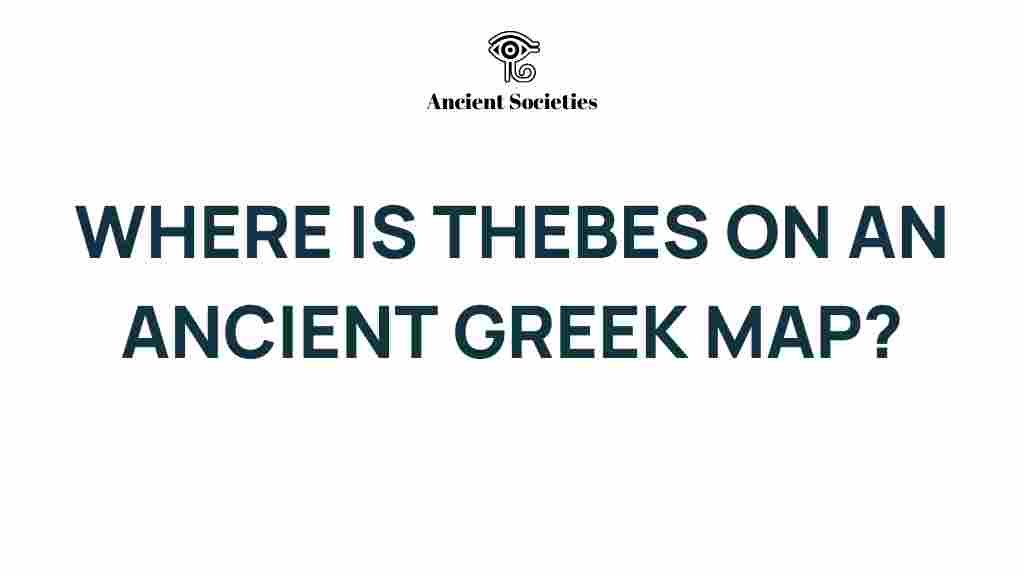Thebes: The Lost City of Ancient Greece
Thebes, an ancient city steeped in rich history and cultural significance, holds a unique place in the annals of Ancient Greece. Located in the region of Boeotia, Thebes was one of the most powerful city-states in Greece, rivaling Athens and Sparta during its prime. This article delves into the fascinating archaeology, history, and culture of Thebes, exploring its rise and fall, its contributions to Greek civilization, and the enduring mythology that surrounds it. Join us as we embark on a journey to unveil the mysteries of Thebes.
The Historical Significance of Thebes
Thebes emerged as a formidable city-state during the late Bronze Age, around the 14th century BCE. Its strategic location allowed it to control trade routes and resources, contributing to its wealth and power. Thebes played a crucial role in various historical events, including:
- The conflict with the Mycenaean civilization
- The rise and fall of the Boeotian League
- The pivotal battles during the Peloponnesian War
As a city-state, Thebes was known for its military prowess, particularly during the 4th century BCE when it defeated Sparta at the Battle of Leuctra in 371 BCE. This victory marked the beginning of Theban hegemony in Greece, showcasing its strength and tactical brilliance.
The Cultural Landscape of Thebes
Thebes was not only a military power but also a vibrant center of culture and the arts. The city fostered notable figures, including:
- Hercules: A hero of Greek mythology, known for his strength and adventures.
- Pindar: One of the greatest lyric poets of Ancient Greece, celebrated for his odes.
- Epaminondas: A brilliant general and statesman credited with innovative military tactics.
The cultural contributions of Thebes extended to theater, philosophy, and the arts, making it an influential hub during its time.
Archaeological Discoveries in Thebes
The exploration of Thebes has revealed a wealth of archaeological treasures that provide insight into its past. Notable discoveries include:
- The Cadmea: The acropolis of Thebes, which housed temples and administrative buildings.
- The Sanctuary of Heracles: A site dedicated to the hero, showcasing the importance of mythology in Theban culture.
- Funerary monuments: Tombs that provide clues about the burial practices and beliefs of the ancient Thebans.
These ruins serve as a testament to the architectural and artistic achievements of Thebes, allowing modern explorers to connect with the city’s illustrious past.
Exploring Thebes: A Step-by-Step Process
For those interested in visiting Thebes and exploring its ancient ruins, here’s a step-by-step guide to make the most of your journey:
- Plan Your Visit: Research the best time to visit Thebes, considering weather and local festivals.
- Arrange Transportation: Choose between renting a car or using public transport to reach Thebes from Athens, which is approximately 80 km away.
- Visit Key Sites: Prioritize the most significant archaeological sites, including the Cadmea and the Sanctuary of Heracles.
- Engage a Guide: Consider hiring a knowledgeable local guide to enrich your understanding of the history and significance of the sites.
- Explore Local Culture: Don’t miss the chance to experience modern Thebes, including local cuisine and festivals.
Troubleshooting Tips for Your Exploration
While exploring Thebes can be a rewarding experience, you may encounter some challenges. Here are some troubleshooting tips:
- Language Barrier: Brush up on basic Greek phrases to enhance communication with locals.
- Site Accessibility: Check the opening hours of archaeological sites in advance, as they can vary seasonally.
- Weather Considerations: Prepare for the weather by dressing in layers and bringing sun protection.
By being prepared, you can ensure a smooth and enjoyable visit to Thebes.
The Mythology of Thebes
Thebes is deeply entwined with Greek mythology, serving as the backdrop for many legendary tales. Among the most notable myths associated with Thebes are:
- The Legend of Oedipus: Perhaps the most famous story, Oedipus was prophesied to kill his father and marry his mother, leading to tragedy and despair.
- The Seven Against Thebes: A story of a doomed expedition led by Polynices against the city, symbolizing the consequences of familial conflict.
- The Birth of Dionysus: Thebes is also known as the birthplace of Dionysus, the god of wine and revelry, highlighting its cultural significance in mythology.
These myths not only shaped the identity of Thebes but also influenced art and literature throughout history.
Conclusion: The Enduring Legacy of Thebes
Thebes, with its rich history, vibrant culture, and profound mythology, remains a cornerstone of Ancient Greece. The archaeological ruins offer a glimpse into a civilization that once thrived, while the tales of its heroes and legends continue to captivate audiences today. Whether you are an avid historian, a lover of mythology, or simply an explorer at heart, Thebes invites you to uncover its secrets and appreciate its lasting impact on the world.
For more information about the archaeological findings in Ancient Greece, visit this resource. If you’re planning a trip to historical sites, check out this guide for helpful tips.
This article is in the category Archaeology and created by AncientSocieties Team
